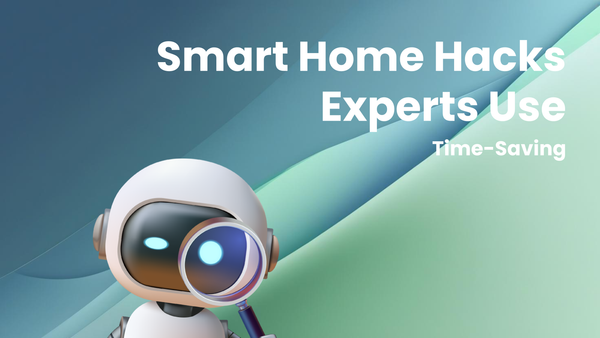Smart Home Pros and Cons: Best Practices Guide

Smart Home Pros and Cons: A Best Practices Guide for the Modern Homeowner
Imagine waking up to the perfect temperature, your coffee already brewing, and your favorite playlist softly filling the air – all without lifting a finger. This is the promise of the smart home. But before you dive headfirst into a connected world, it's crucial to understand the full picture. Many homeowners make the mistake of buying the latest smart gadgets without a cohesive plan, leading to frustration and wasted money. This article provides a comprehensive look at the pros and cons of smart home technology, offering a best practices guide to help you create a truly intelligent and functional living space. By the end of this article, you'll understand the benefits and risks of smart home tech, learn how to strategize your smart home setup, and make informed decisions to enhance your life and protect your privacy.
I. Understanding the Smart Home Ecosystem
The "smart home" encompasses a range of devices and systems that automate tasks, enhance convenience, and improve security. At its core, a smart home is a network of interconnected devices, often controlled remotely via a smartphone app, voice command, or automated schedules. This isn't just about fancy gadgets; it's about creating a more efficient and responsive living environment.
A. A Brief History and Evolution
The concept of automating household tasks dates back to the early 20th century, with inventions like automatic toasters and washing machines. However, the modern smart home emerged with the advent of the internet and the proliferation of connected devices.
- Early Stages (1970s-1990s): X10 protocol emerged, enabling basic control of lighting and appliances over existing electrical wiring. Think clunky interfaces and limited functionality.
- The Internet Era (2000s): The internet allowed for remote control and monitoring, but adoption remained limited due to cost and complexity.
- The Smart Home Boom (2010s-Present): The rise of smartphones, voice assistants (like Amazon Alexa and Google Assistant), and affordable Wi-Fi enabled devices propelled smart home technology into the mainstream. Now, even your refrigerator can order groceries.
B. Core Components of a Smart Home
A typical smart home ecosystem includes various categories of devices:
- Smart Lighting: Control lights remotely, schedule lighting scenes, and adjust brightness/color.
- Example: Philips Hue bulbs, which can be controlled via a smartphone app and integrated with other smart home devices.
- Smart Thermostats: Learn your heating and cooling preferences, optimize energy consumption, and allow remote temperature adjustments.
- Example: Nest Learning Thermostat, known for its adaptive learning capabilities and energy-saving features.
- Smart Security Systems: Monitor your home with cameras, motion sensors, and door/window sensors, providing real-time alerts and remote access.
- Example: Ring Alarm, a comprehensive security system that includes video doorbells, security cameras, and professional monitoring options.
- Smart Entertainment: Stream music and video, control your TV, and create immersive entertainment experiences.
- Example: Sonos multi-room audio system, which allows you to play music in different rooms simultaneously and control it via a smartphone app.
- Smart Appliances: Control appliances like refrigerators, ovens, and washing machines remotely, and receive notifications about their status.
- Example: Samsung smart refrigerators with built-in touchscreens and integration with grocery delivery services.
- Voice Assistants: Act as a central hub for controlling your smart home devices with voice commands.
- Example: Amazon Echo (Alexa) and Google Home (Google Assistant), which can control a wide range of smart home devices and provide information.
C. Understanding Communication Protocols
Smart home devices communicate using different protocols, each with its strengths and weaknesses. Understanding these protocols is crucial for ensuring compatibility and performance.
- Wi-Fi: The most common protocol, used by many smart home devices for direct connection to your home network. It's simple to setup and offers good bandwidth, but can overload your router with too many devices.
- Bluetooth: Short-range wireless technology ideal for connecting devices like smart locks and speakers to your smartphone or other hub. Power efficient but limited range.
- Zigbee: A low-power, mesh network protocol designed for smart home devices. It creates a robust and reliable network by allowing devices to communicate with each other, extending the range and improving stability. Less common than Wi-Fi but great for larger homes.
- Z-Wave: Another mesh network protocol similar to Zigbee, but with a focus on security and interoperability. Often used in smart security systems.
- Matter: The new kid on the block, Matter is an open-source connectivity standard aimed at simplifying smart home interoperability. It promises to make it easier for devices from different manufacturers to work together seamlessly.
II. The Bright Side: Pros of a Smart Home
Smart home technology offers a compelling range of benefits, enhancing convenience, security, and energy efficiency.
A. Enhanced Convenience and Automation
- Hands-Free Control: Control your lights, temperature, and entertainment system with voice commands, freeing up your hands and simplifying daily tasks.
- Example: "Alexa, turn off the living room lights" or "Hey Google, play my favorite playlist on Spotify."
- Automated Routines: Create automated routines that trigger multiple actions based on specific events or times.
- Example: A "Good Morning" routine that turns on the lights, adjusts the thermostat, and starts brewing coffee when your alarm goes off.
- Remote Access: Control your home from anywhere with a smartphone or tablet, allowing you to check on your property, adjust the temperature, or unlock the door for a guest.
- Example: Adjusting the thermostat remotely before you arrive home from vacation or checking security camera footage while you're at work.
- Simplifying Daily Tasks: Automate repetitive tasks like watering the lawn, vacuuming the floor, or ordering groceries.
- Example: A robotic vacuum cleaner that automatically cleans your floors on a schedule or a smart sprinkler system that adjusts watering based on weather conditions.
B. Improved Security and Peace of Mind
- Remote Monitoring: Monitor your home with security cameras and receive real-time alerts if suspicious activity is detected.
- Example: A smart doorbell that sends you a notification when someone is at your door, even when you're not home.
- Intrusion Detection: Receive alerts if doors or windows are opened unexpectedly, deterring potential intruders.
- Example: Smart door/window sensors that trigger an alarm and send you a notification if a break-in is detected.
- Emergency Assistance: Smart home systems can automatically contact emergency services in case of a fire, carbon monoxide leak, or medical emergency.
- Example: Smart smoke detectors that automatically notify the fire department if a fire is detected, even if you're not home.
- Increased Awareness: Gain greater awareness of what's happening in and around your home, providing peace of mind.
- Example: Checking security camera footage to see if your kids arrived home safely from school or monitoring the temperature in your baby's room.
C. Energy Efficiency and Cost Savings
- Smart Thermostats: Optimize your heating and cooling usage, reducing energy consumption and lowering your utility bills. Studies have shown that smart thermostats can save homeowners up to 10-12% on heating and 15% on cooling costs.
- Example: A Nest Learning Thermostat that learns your preferred temperatures and automatically adjusts the thermostat based on your schedule.
- Smart Lighting: Use energy-efficient LED bulbs and automate lighting schedules to reduce energy waste.
- Example: Philips Hue bulbs that can be programmed to turn off automatically when you leave a room.
- Appliance Control: Monitor and control your appliances remotely, preventing energy waste and ensuring they are turned off when not in use.
- Example: A smart plug that allows you to turn off appliances remotely, such as a coffee maker or a space heater.
- Water Monitoring: Detect leaks and monitor water usage, preventing water waste and reducing your water bill.
- Example: A smart water leak detector that sends you an alert if it detects a leak, allowing you to take action quickly and prevent water damage.
D. Accessibility and Aging in Place
- Voice Control: Allow individuals with mobility limitations to control their home environment with voice commands.
- Example: Controlling lights, temperature, and entertainment systems with voice commands.
- Remote Monitoring: Enable caregivers to monitor elderly or disabled individuals remotely, ensuring their safety and well-being.
- Example: A smart security system with cameras and sensors that allows caregivers to check on their loved ones remotely.
- Automated Assistance: Provide automated assistance with daily tasks, such as medication reminders and fall detection.
- Example: A smart medication dispenser that reminds elderly individuals to take their medication on time.
- Increased Independence: Empower individuals to live independently for longer, improving their quality of life.
- Example: A smart home system that allows elderly individuals to control their home environment and access assistance when needed.
III. The Darker Side: Cons and Challenges of Smart Homes
While the benefits of smart homes are undeniable, it's important to acknowledge the potential drawbacks and challenges.
A. Security and Privacy Concerns
- Data Breaches: Smart home devices collect vast amounts of personal data, making them vulnerable to data breaches and hacking. In 2020, Ring security cameras were hacked, allowing intruders to access live feeds and even speak to homeowners.
- Mitigation: Choose devices from reputable brands with strong security measures, use strong passwords, and regularly update your device firmware.
- Privacy Violations: Smart home devices can collect sensitive information about your habits and routines, raising privacy concerns. Voice assistants like Alexa and Google Assistant record your voice commands, which could potentially be used for targeted advertising or other purposes.
- Mitigation: Review the privacy policies of your smart home devices, disable features you're uncomfortable with, and use privacy-focused alternatives.
- Device Vulnerabilities: Many smart home devices have known security vulnerabilities that can be exploited by hackers. In 2016, a massive DDoS attack was launched using compromised IoT devices, including smart cameras and routers.
- Mitigation: Keep your devices updated with the latest security patches, use a strong firewall, and consider using a separate network for your smart home devices.
- Vendor Lock-in: Some smart home ecosystems are designed to lock you into a specific brand or platform, limiting your choices and making it difficult to switch to alternative solutions.
- Mitigation: Choose devices that support open standards like Matter, which promote interoperability and reduce vendor lock-in.
B. Cost and Complexity
- Initial Investment: Setting up a smart home can be expensive, especially if you want to automate multiple devices and systems. A fully equipped smart home can easily cost thousands of dollars.
- Mitigation: Start small and gradually add devices over time, focusing on the areas that will provide the most benefit. Look for sales and discounts.
- Ongoing Costs: In addition to the initial investment, you may also need to pay for subscription services, such as cloud storage for security camera footage or professional monitoring for your security system.
- Mitigation: Carefully evaluate the subscription fees associated with each device and factor them into your budget. Consider self-monitoring options to save money.
- Technical Expertise: Setting up and troubleshooting smart home devices can be complex, requiring technical knowledge and skills. Many users struggle with network configuration, device compatibility, and software updates.
- Mitigation: Read the manuals carefully, watch online tutorials, and seek help from online forums or professional installers.
- Compatibility Issues: Different smart home devices may not be compatible with each other, requiring you to use multiple apps and platforms. This can create a fragmented and frustrating user experience.
- Mitigation: Choose devices that support common standards like Matter and ensure they are compatible with your existing smart home ecosystem.
C. Reliability and Dependence
- Internet Dependence: Smart home devices rely on a stable internet connection to function properly. If your internet goes down, your smart home may become unusable.
- Mitigation: Invest in a reliable internet connection and consider a backup internet connection in case of outages.
- System Failures: Smart home devices can fail or malfunction, causing disruptions and inconveniences. A power outage can render many smart home devices useless.
- Mitigation: Invest in a UPS (uninterruptible power supply) for critical devices like your router and security system. Choose devices from reputable brands known for their reliability.
- Software Updates: Smart home devices require regular software updates to maintain security and functionality. These updates can sometimes be disruptive or cause compatibility issues.
- Mitigation: Enable automatic software updates, but monitor your devices after updates to ensure they are working properly.
- Over-Reliance: Becoming too reliant on smart home technology can make you less self-sufficient and more vulnerable in case of system failures.
- Mitigation: Maintain a backup plan for critical tasks and avoid becoming overly dependent on smart home automation.
D. Ethical Considerations
- Surveillance and Data Collection: The pervasive nature of smart home devices raises ethical concerns about surveillance and data collection. Are you comfortable with your devices constantly monitoring your activities?
- Algorithmic Bias: Smart home algorithms can be biased, leading to unfair or discriminatory outcomes. For example, facial recognition systems may be less accurate for people of color.
- Environmental Impact: The production and disposal of smart home devices can have a negative environmental impact. E-waste is a growing problem, and many smart home devices are not easily recyclable.
- Social Isolation: Over-reliance on smart home technology can lead to social isolation and a decline in human interaction.
IV. Best Practices for Building a Smart Home
Creating a successful smart home requires careful planning, informed decision-making, and ongoing maintenance.
A. Planning and Strategy
- Define Your Goals: What do you want to achieve with your smart home? Are you looking to improve security, save energy, enhance convenience, or improve accessibility?
- Assess Your Needs: Identify the areas of your home that would benefit most from smart home technology. Prioritize your needs based on your budget and priorities.
- Create a Budget: Determine how much you are willing to spend on your smart home. Factor in both the initial cost of devices and ongoing subscription fees.
- Choose a Platform: Select a smart home platform that meets your needs and is compatible with the devices you want to use. Consider factors like ease of use, compatibility, security, and privacy.
B. Device Selection and Installation
- Research and Compare: Before buying any smart home device, research and compare different brands and models. Read reviews, check specifications, and compare prices.
- Prioritize Security: Choose devices from reputable brands with strong security measures. Look for devices that support encryption, two-factor authentication, and regular security updates.
- Ensure Compatibility: Make sure the devices you choose are compatible with your smart home platform and other devices. Check for certifications like Matter.
- Professional Installation: Consider hiring a professional installer for complex installations, such as security systems or smart lighting systems.
C. Security and Privacy Measures
- Strong Passwords: Use strong, unique passwords for all your smart home devices and accounts. Avoid using default passwords.
- Two-Factor Authentication: Enable two-factor authentication whenever possible to add an extra layer of security to your accounts.
- Network Security: Secure your home network with a strong password and a firewall. Consider using a separate network for your smart home devices.
- Privacy Settings: Review the privacy settings of your smart home devices and disable features you're uncomfortable with.
- Regular Updates: Keep your smart home devices updated with the latest security patches and firmware updates.
D. Maintenance and Troubleshooting
- Monitor Your Devices: Regularly monitor your smart home devices to ensure they are working properly. Check for error messages or unusual behavior.
- Troubleshooting: Learn how to troubleshoot common smart home problems, such as connectivity issues or device malfunctions. Consult the device manuals or online forums for help.
- Backup and Recovery: Create backups of your smart home settings and configurations so you can easily restore them in case of a system failure.
- Stay Informed: Stay up-to-date on the latest security threats and vulnerabilities related to smart home technology. Follow security blogs and news outlets.
E. Specific Recommendations for Different Device Categories
- Security Cameras: Choose cameras with local storage options in addition to cloud storage, for added privacy. Regularly review footage.
- Voice Assistants: Be mindful of what you say near voice assistants. Review and delete voice recordings periodically. Mute the microphone when not in use.
- Smart Locks: Use smart locks with physical key backups in case of power outages or system failures. Regularly check the batteries.
- Smart Thermostats: Program your thermostat carefully to optimize energy savings without sacrificing comfort.
V. The Future of Smart Homes
Smart home technology is constantly evolving, with new innovations and trends emerging all the time.
A. Emerging Technologies
- Artificial Intelligence (AI): AI is becoming increasingly integrated into smart home devices, enabling them to learn your preferences, anticipate your needs, and automate tasks more intelligently.
- Edge Computing: Edge computing allows smart home devices to process data locally, reducing latency and improving privacy.
- 5G Connectivity: 5G technology will enable faster and more reliable wireless connections for smart home devices.
- Augmented Reality (AR): AR applications will allow you to visualize and interact with your smart home devices in new ways.
B. Trends and Predictions
- Increased Interoperability: Standards like Matter will make it easier for devices from different manufacturers to work together seamlessly.
- Personalized Experiences: Smart home devices will become more personalized, adapting to your individual needs and preferences.
- Proactive Automation: Smart homes will become more proactive, anticipating your needs and automating tasks without requiring manual input.
- Focus on Sustainability: Smart home technology will play an increasingly important role in promoting energy efficiency and sustainability.
C. Potential Societal Impact
- Aging in Place: Smart home technology will enable elderly individuals to live independently for longer, reducing the burden on caregivers and healthcare systems.
- Accessibility for All: Smart home technology will improve accessibility for individuals with disabilities, empowering them to live more independent and fulfilling lives.
- Economic Growth: The smart home industry will continue to drive economic growth, creating new jobs and opportunities.
- Ethical Considerations: Society will need to address the ethical considerations raised by smart home technology, such as privacy, security, and algorithmic bias.
The smart home revolution is here, promising a future of convenience, security, and efficiency. By understanding the pros and cons, adopting best practices, and staying informed about emerging trends, you can harness the power of smart home technology to create a living space that truly enhances your life. Don't just buy gadgets, design an ecosystem.
Now that you understand the landscape, take some time to reflect on your needs and priorities. What problems can a smart home actually solve for you? Start small, focusing on one key area like security or energy efficiency. Then, after a few months, evaluate your success and consider expanding your smart home ecosystem thoughtfully.




